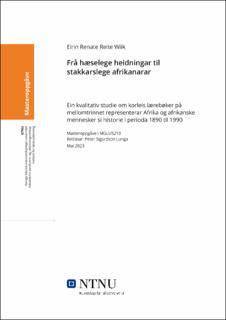| dc.contributor.advisor | Lunga, Sigurdson Peter | |
| dc.contributor.author | Wiik, Eirin Renate Reite Wiik | |
| dc.date.accessioned | 2023-07-25T17:22:51Z | |
| dc.date.available | 2023-07-25T17:22:51Z | |
| dc.date.issued | 2023 | |
| dc.identifier | no.ntnu:inspera:147067678:39517339 | |
| dc.identifier.uri | https://hdl.handle.net/11250/3081372 | |
| dc.description.abstract | Oppgåva spring ut av ein nysgjerrigheit om eit tema eg kan veldig lite om, og som eg har
hatt ein interessa av, heilt sidan barneskulen. Kvifor vi berre lærte om slavehandelen, det
gamle Egypt og vart opplærte til å sjå på afrikanske menneske som stakkarslege, har eg
lenge lurt på. Dette var ein av årsakene til at eg ville undersøkje dette i denne oppgåva.
Formålet med denne masteroppgåva er å undersøkje representasjonar av Afrika og
afrikanske menneske, og prøve å gi ein forklaring på kva desse representasjonane kan ha
komme av. Dette vil eg prøve å finne ut av gjennom ein kvalitativ forskingsanalyse, der eg
tek føre meg ein lærebokanalyse av 10 ulike bøker frå 1890- til 1990- talet. I tillegg til
lærebøkene, tek eg også i bruk dei tilhøyrande læreplanane for å sjå kva politikken og
samfunnet meinte det var viktig at elevane skulle lære. Årsaka til denne problemstillinga,
kjem av manglande forsking av feltet, og eit ønskje om å kunne bidrege meir til denne
forskinga.
Representasjonane av dei afrikanske menneska og den Afrikanske historie har endra seg
mykje frå 1890, og fram til 1990. Lærebøkene gjekk i frå å omtale den afrikanske
befolkning som “hæslege negera”, som trengte hjelp av den kvite mann til å bli redda frå
sinn heidenskap, til å bli ein meir stakkarsleg befolkning. Desse endringane har kommen av
både politiske- og samfunnsendringar, noko ein også ser går igjen i dei ulike lære- og
mønsterplanane. Kristendommen var viktig, og bibelen vart ofte brukt for å grunngjeve
blant anna behandlinga av slavane under slavehandelen. Men kvifor har desse endringane
skjedd, og har slavehandelen påverka synet på dei afrikanske menneska? | |
| dc.description.abstract | This thesis started with the curiosity about a theme I didn’t know a lot about. A theme
which I have had an interest about since elementary school. Why did we just learn about
the Slave trade, Ancient Egypt and was thought to look at African people as pitiful people,
have I wondered about for a long time. This was one of the reasons I wanted to investigate
this, in this master thesis.
The purpose of this master thesis is to investigate the representation of Africa and the
African people and try to find an explanation to where the representation came from. This I
will try to do through a qualitative research analysis, where I use a textbook analysis of 10
different textbooks from the 1890 to the 1990. In addition to the textbooks, I will use
associated curricula to have a look at what the politics and the society wanted the students
to learn. I choose this theme because there is a lack of research about it, and a wish to
contribute to the research.
The representation of the African people and the African story has changed a lot from the
1890, to the 1990. The textbooks first started by calling the African people as “hideous
negroes”, that needed the white man to come and save them from their paganism to a
more pitiful people. The changes came from developments in both the politics and in
society, and in the associated curricula. Christianity was important, and the bible was often
used to justify the treatment of the slaves in the slave trade. But what is the reason for this,
and has the slave trade had an impact in how they viewed the African people? | |
| dc.language | nno | |
| dc.publisher | NTNU | |
| dc.title | Frå hæselege heidningar til stakkarslege afrikanarar | |
| dc.type | Master thesis | |
